8.5: Stub Tuning
( \newcommand{\kernel}{\mathrm{null}\,}\)
In practice, most sources are connected to a transmission line through a series resistance matched to the line. This eliminates transient reflections when the excitation is turned on or off. To maximize the power flow to a load, it is also necessary for the load impedance reflected back to the source to be equal to the source impedance and thus equal to the characteristic impedance of the line, Z0. This matching of the load to the line for an arbitrary termination can only be performed by adding additional elements along the line.
Usually these elements are short circuited transmission lines, called stubs, whose lengths can be varied. The reactance of the stub can be changed over the range from −j∞ to j∞ simply by varying its length, as found in Section 8-3-2, for the short circuited line. Because stubs are usually connected in parallel to a transmission line, it is more convenient to work with admittances rather than impedances as admittances in parallel simply add.
Use of the Smith Chart for Admittance Calculations
Fortunately the Smith chart can also be directly used for admittance calculations where the normalized admittance is defined as
Yn(z)=Y(z)Y0=1Zn(z)
If the normalized load admittance YnL is known, straightforward impedance calculations first require the computation
ZnL=1/YnL
so that we could enter the Smith chart at ZnL. Then we rotate by the required angle corresponding to 2kz and read the new Zn(z). Then we again compute its reciprocal to find
Yn(z)=1/Zn(z)
The two operations of taking the reciprocal are tedious. We can use the Smith chart itself to invert the impedance by using the fact that the normalized impedance is inverted by a λ/4 section of line, so that a rotation of Γ(z) by 180∘ changes a normalized impedance into its reciprocal. Hence, if the admittance is given, we enter the Smith chart with a given value of normalized admittance Yn and rotate by 180∘ to find Zn. We then rotate by the appropriate number of wavelengths to find Zn(z). Finally, we again rotate by 180∘ to find Yn(z)=1/Zn(z). We have actually rotated the reflection coefficient by an angle of 2π+2kz. Rotation by 2π on the Smith chart, however, brings us back to wherever we started, so that only the 2kz rotation is significant. As long as we do an even number of π rotations by entering the Smith chart with an admittance and leaving again with an admittance, we can use the Smith chart with normalized admittances exactly as if they were normalized impedances.
The load impedance on a 50-Ohm line is
ZL=50(1+j)
What is the admittance of the load?
SOLUTION
By direct computation we have
YL=1ZL=150(1+j)=(1−j)100
To use the Smith chart we find the normalized impedance at A in Figure 8-23:
ZnL=1+j
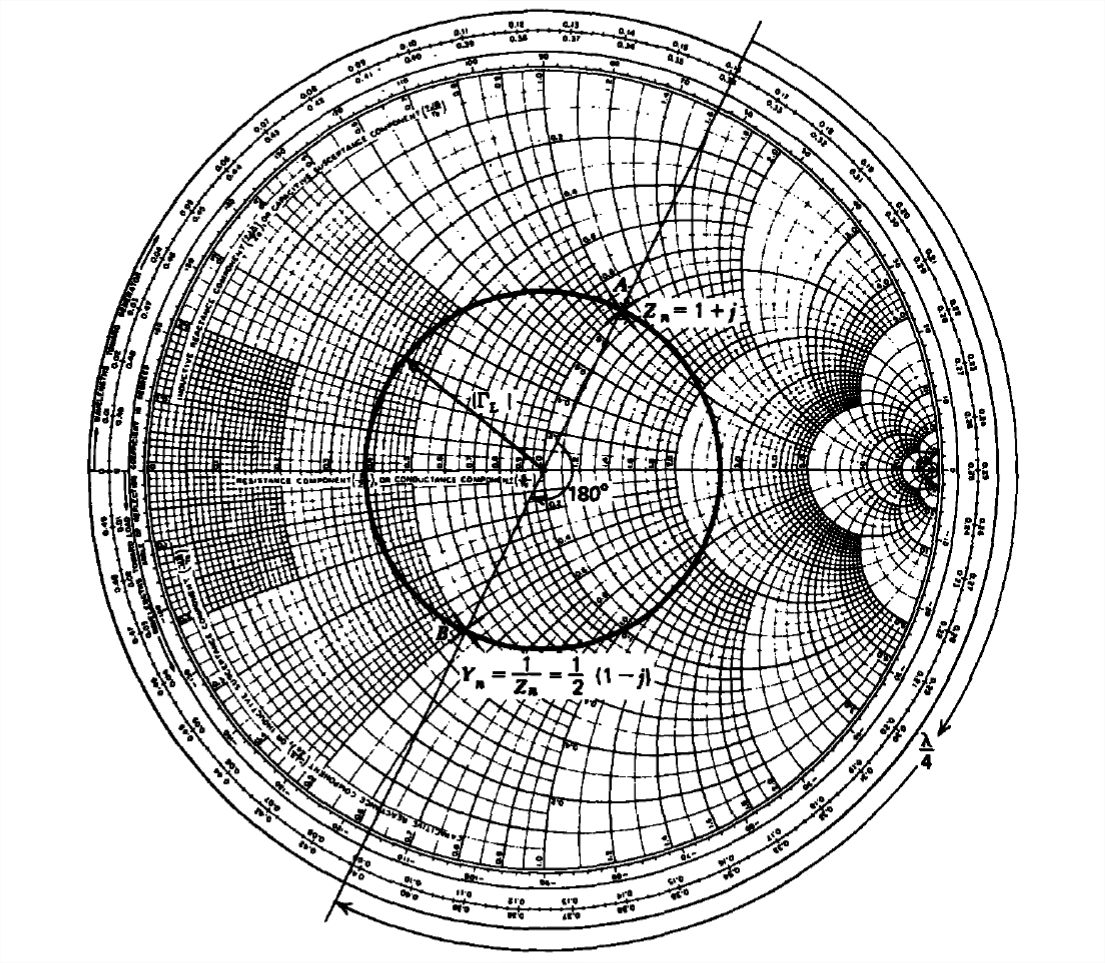
The normalized admittance that is the reciprocal of the normalized impedance is found by locating the impedance a distance λ/4 away from the load end at B:
YnL=0.5(1−j)⇒YL=YnY0=(1−j)/100
Note that the point B is just 180∘ away from A on the constant |ΓL| circle. For more complicated loads the Smith chart is a convenient way to find the reciprocal of a complex number.
Single-Stub Matching
A termination of value ZL=50(1+j) on a 50-Ohm transmission line is to be matched by means of a short circuited stub at a distance L from the load, as shown in Figure 8-24a. We need to find the line length l1 and the length of the stub l2 such that the impedance at the junction is matched to the line (Zin=50Ohm). Then we know that all further points to the left of the junction have the same impedance of 50Ohms.
Because of the parallel connection, it is simpler to use the Smith chart as an admittance transformation. The normalized load admittance can be computed using the Smith chart by rotating by 180∘ from the normalized load impedance at A, as was shown in Figure 8-23 and Example 8-3,
ZnL=1+j
to yield
YnL=0.5(1−j)
at the point B.
Now we know from Section 8-3-2 that the short circuited stub can only add an imaginary component to the admittance. Since we want the total normalized admittance to be unity to the left of the stub in Figure 8-24
Yin=Y1+Y2=1
when YnL is reflected back to be Y1 it must wind up on the circle whose real part is 1 (as Y2 can only be imaginary), which occurs either at C or back at A allowing l1 to be either 0.25λ at A or (0.25+0.177)λ=0.427λ at C (or these values plus any integer multiple of λ/2). Then Y1 is either of the following two conjugate values:
Y1={1+j,l1=0.25λ(A)1−j,l1=0.427λ(C)
For Yin to be unity we must pick Y2 to have an imaginary part to just cancel the imaginary part of Y1:
Y2={−j,l1=0.25λ+j,l1=0.427λ
which means, since the shorted end has an infinite admittance at D that the stub must be of length such as to rotate the admittance to the points E or F requiring a stub length l2 of (λ/8)(E) or (3λ/8)(F) (or these values plus any integer multiple of λ/2). Thus, the solutions can be summarized as
l1=0.25λ+nλ/2,l2=λ/8+mλ/2
or
l1=0.427λ+nλ/2,l2=3λ/8+mλ/2
where n and m are any nonnegative integers (including zero).
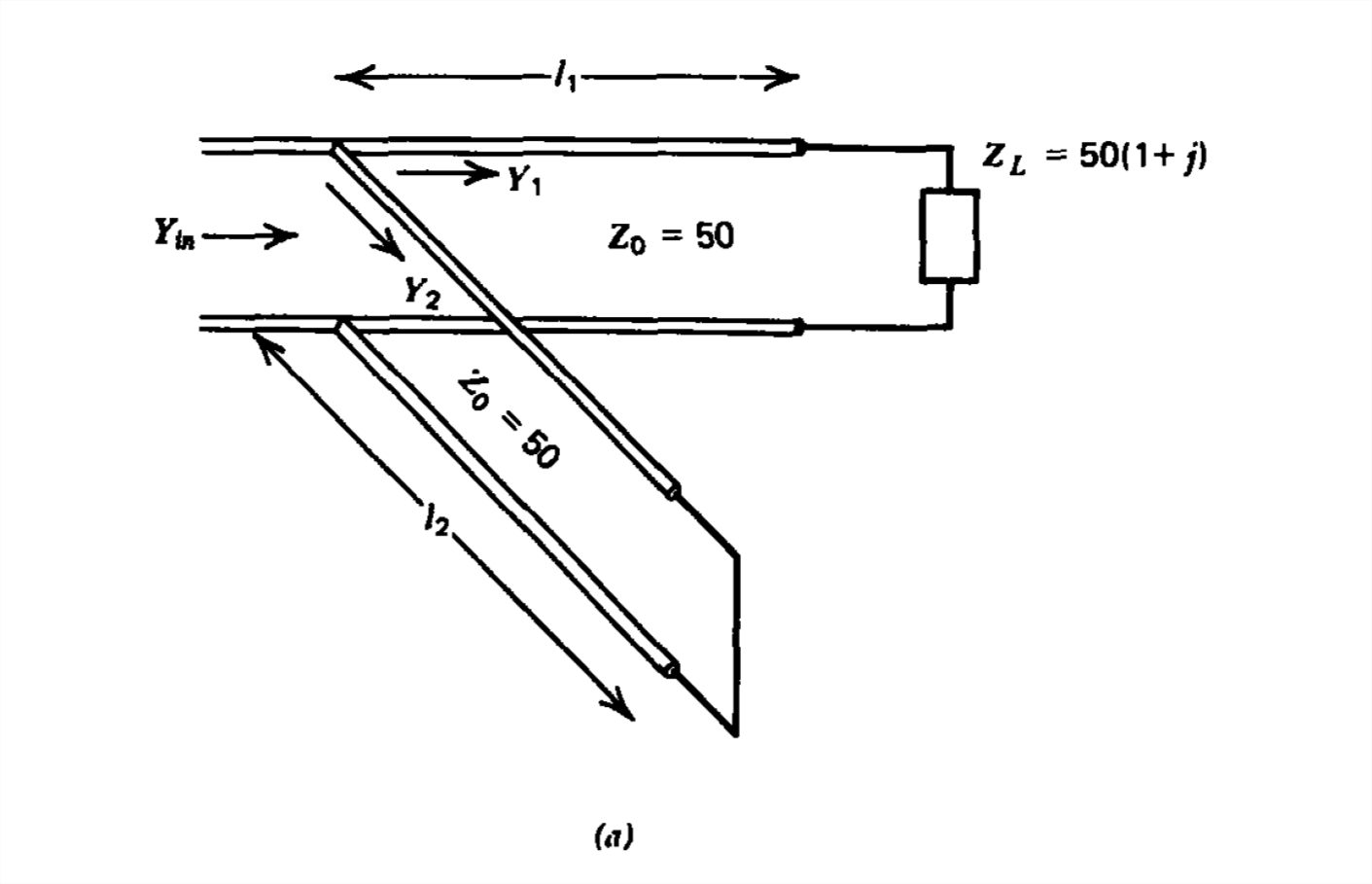

Figure 8-24 (a) A single stub tuner consisting of a variable length short circuited line l2 can match any load to the line by putting the stub at the appropriate distance l1, from the load. (b) Smith chart construction. (c) Voltage standing wave pattern.

When the load is matched by the stub to the line, the VSWR to the left of the stub is unity, while to the right of the stub over the length l1 the reflection coefficient is
ΓL=ZnL−1ZnL+1=j2+j
which has magnitude
|ΓL|=1/√5≈0.447
so that the voltage standing wave ratio is
VSWR=1+|ΓL|1−|ΓL|≈2.62
The disadvantage to single-stub tuning is that it is not easy to vary the length l1. Generally new elements can only be connected at the ends of the line and not inbetween.
Double-Stub Matching
This difficulty of not having a variable length line can be overcome by using two short circuited stubs a fixed length apart, as shown in Figure 8-25a. This fixed length is usually 38λ. A match is made by adjusting the length of the stubs l1 and
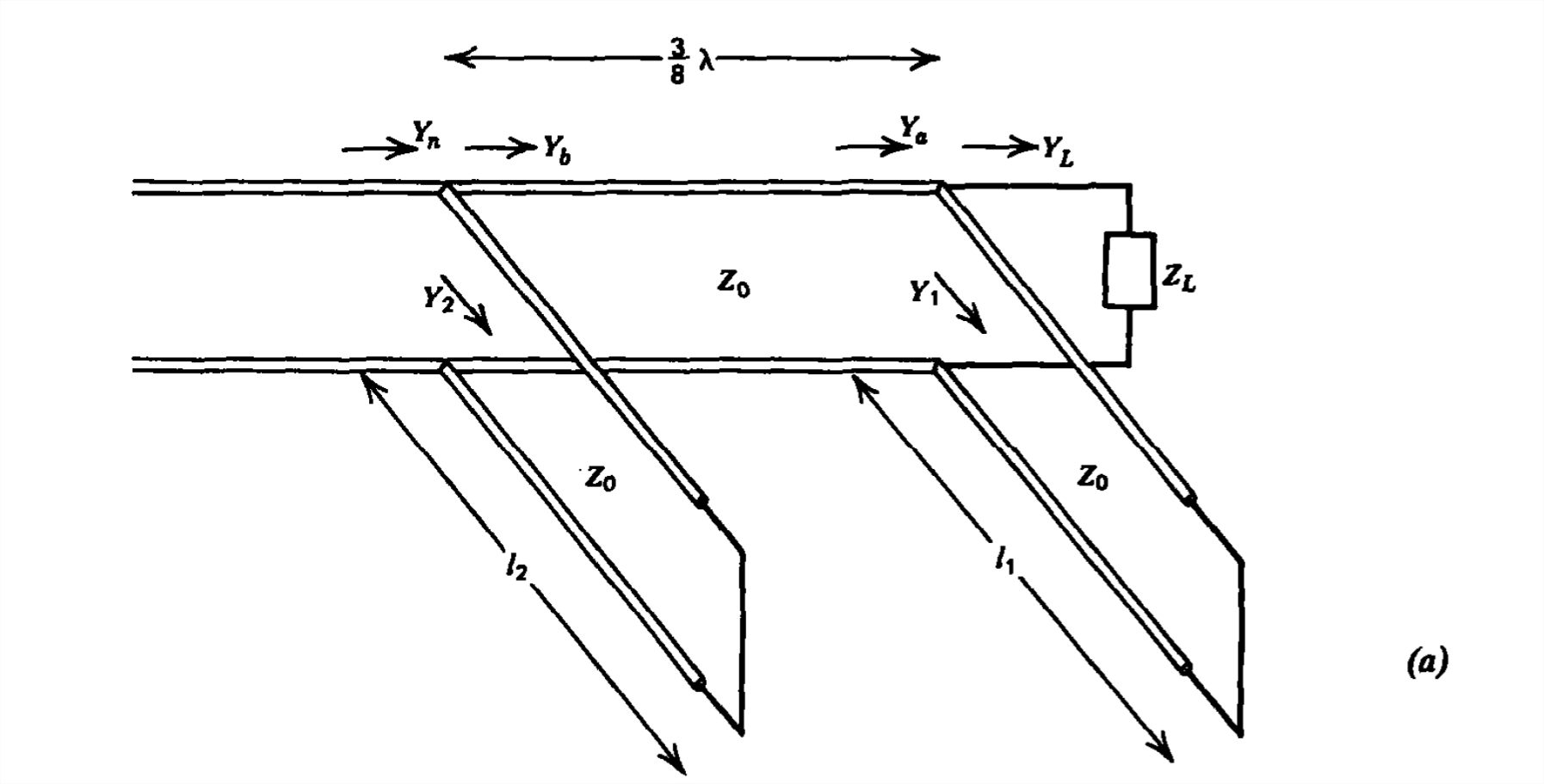

\l2. One problem with the double-stub tuner is that not all loads can be matched for a given stub spacing.
The normalized admittances at each junction are related as
Ya=Y1+YLYn=Y2+Yb
where Y1 and Y2 are the purely reactive admittances of the stubs reflected back to the junctions while Yb is the admittance of Ya reflected back towards the load by 38λ. For a match we require that Yn be unity. Since Y2 is purely imaginary, the real part of Yb must lie on the circle with a real part of unity. Then Ya must lie somewhere on this circle when each point on the circle is reflected back by 38λ. This generates another circle that is 32π back in the counterclockwise direction as we are moving toward the load, as illustrated in Figure 8-25b. To find the conditions for a match, we work from left to right towards the load using the following reasoning:
- Since Y2 is purely imaginary, the real part of Yb must lie on the circle with a real part of unity, as in Figure 8-25b.
- Every possible point on Yb must be reflected towards the load by 38λ to find the locus of possible match for Ya. This generates another circle that is 32π back in the counterclockwise direction as we move towards the load, as in Figure 8-25b.
Again since Y1 is purely imaginary, the real part of Ya must also equal the real part of the load admittance. This yields two possible solutions if the load admittance is outside the forbidden circle enclosing all load admittances with a real part greater than 2. Only loads with normalized admittances whose real part is less than 2 can be matched by the double-stub tuner of 38λ spacing. Of course, if a load is within the forbidden circle, it can be matched by a double-stub tuner if the stub spacing is different than 38λ.
The load impedance ZL=50(1+j) on a 50-Ohm line is to be matched by a double-stub tuner of 38λ spacing. What stub lengths l1 and l2 are necessary?
SOLUTION
The normalized load impedance ZnL=1+j corresponds to a normalized load admittance:
YnL=0.5(1−j)
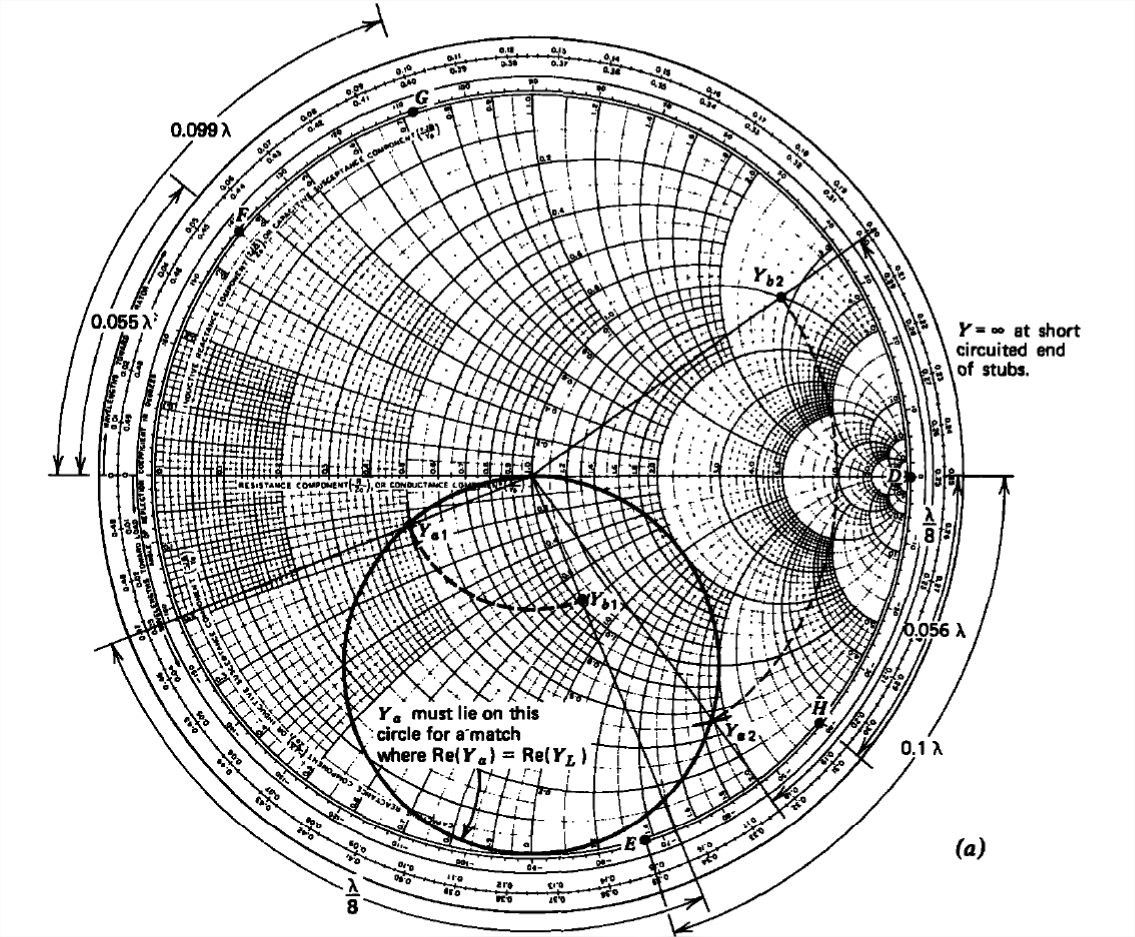
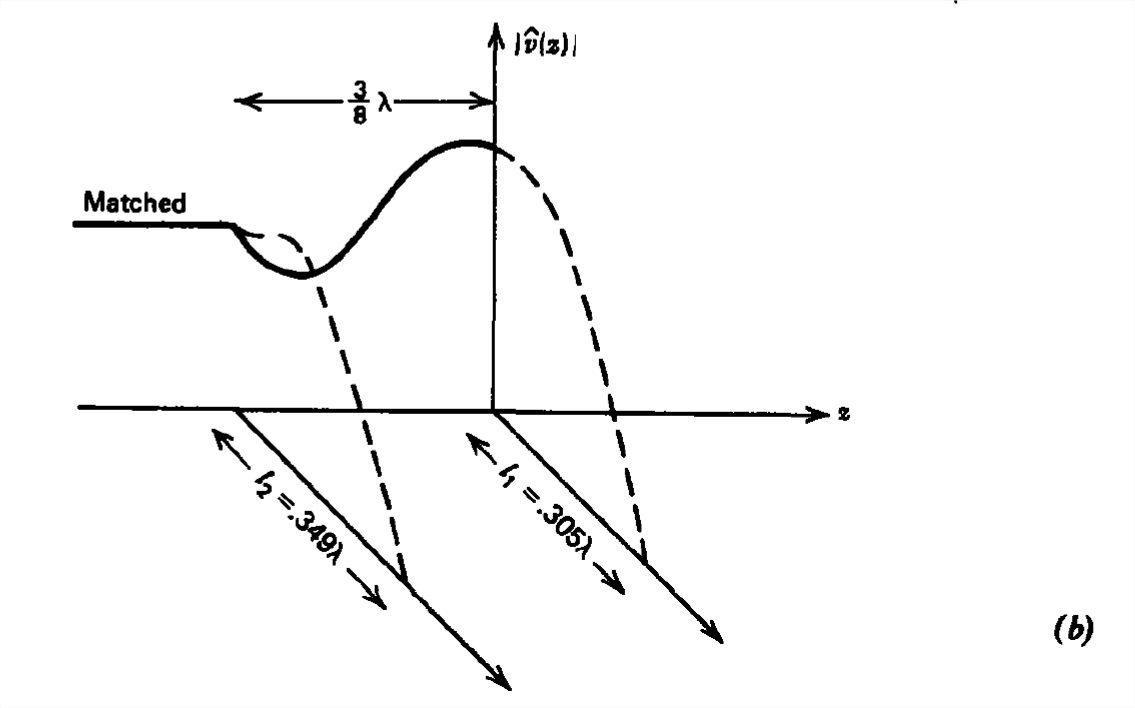
Then the two solutions for Ya lie on the intersection of the circle shown in Figure 8-26a with the r=0.5circle:
Ya1=0.5−0.14jYa2=0.5−1.85j
We then find Y1 by solving for the imaginary part of the upper equation in (13):
Y1=jIm(Ya−YL)={0.36j⇒l1=0.305λ(F)−1.35j⇒l1=0.1λ(E)
By rotating the Ya solutions by 38λ back to the generator (270∘ clockwise, which is equivalent to 90∘ counterclockwise), their intersection with the r=1 circle gives the solutions for Yb as
Yb1=1.0−0.72jYb2=1.0+2.7j
This requires Y2 to be
Y2=−jIm(Yb)={0.72j⇒l2=0.349λ(G)−2.7j⇒l2=0.056λ(H)
The voltage standing wave pattern along the line and stubs is shown in Figure 8.26b. Note the continuity of voltage at the junctions. The actual stub lengths can be those listed plus any integer multiple of λ/2.


